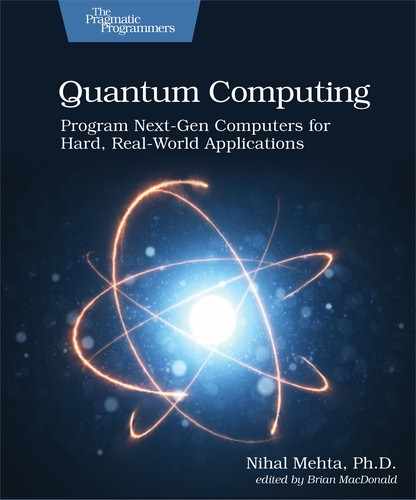Bottom Line
Although quantum gates are at the center of quantum computing and form the bulk of the statements in any quantum program, they just do three things:
Unlike classical computing, which has a wide range of ways to manipulate data, quantum computing crunches out a solution to hugely complex problems merely by tinkering with qubelets. Looking back at the coin-toss analogy in Quantum Computing in Thirty Seconds, it’s as if you’re tweaking the spinning coins so that they land on the faces corresponding to the correct solution.
Like a fingerprint, each gate has its own distinct
matrix, which completely codifies how a quantum state
is modified. These matrices essentially document
how the gate modifies the number of pentagon ![]() and triangle
and triangle ![]() qubelets as
well as how the relative difference in their rotations
is changed. Or, if you prefer to limit the
number of things you’re juggling in your head, you
can equivalently think in terms of how the
triangle
qubelets as
well as how the relative difference in their rotations
is changed. Or, if you prefer to limit the
number of things you’re juggling in your head, you
can equivalently think in terms of how the
triangle ![]() qubelets are
rotated, as described in
Intuitively Analyzing the Quantum Gate Matrix.
qubelets are
rotated, as described in
Intuitively Analyzing the Quantum Gate Matrix.
The various gates in quantum programming give a range of preset ways in which to switch, split, and rotate qubelets. These simplify declaring these gates in your quantum programs. But if you need to introduce quantum effects with finer control, you can use the Universal Gates, which give you complete freedom in how you want to mold the qubelets.
Using matrices to represent the quantum gates also leads to a handy way to work out how a chain of quantum gates affects a qubit: multiplying the gate matrices written in the reverse order of when they act on the qubit gives the final state of the qubit. Ironically, even though matrix multiplication mirrors how qubits change, don’t think of your quantum program as one big matrix multiplication. The reason is that as the number of qubits increases, matrix multiplication quickly gets unwieldy on classical computers, as we’ll see in the next chapter. The true value of matrices is that they help in building patterns that can then be extrapolated to larger problems, as you’ll learn in Chapter 10, Quantum Search.
But, first, in the next chapter, you’ll extend the matrix technique to circuits with multiple qubits. Specifically, you’ll develop matrices for multi-qubit gates, such as the CNOT and CCNOT gates and also see how these gates are paired up with single qubit gates.
